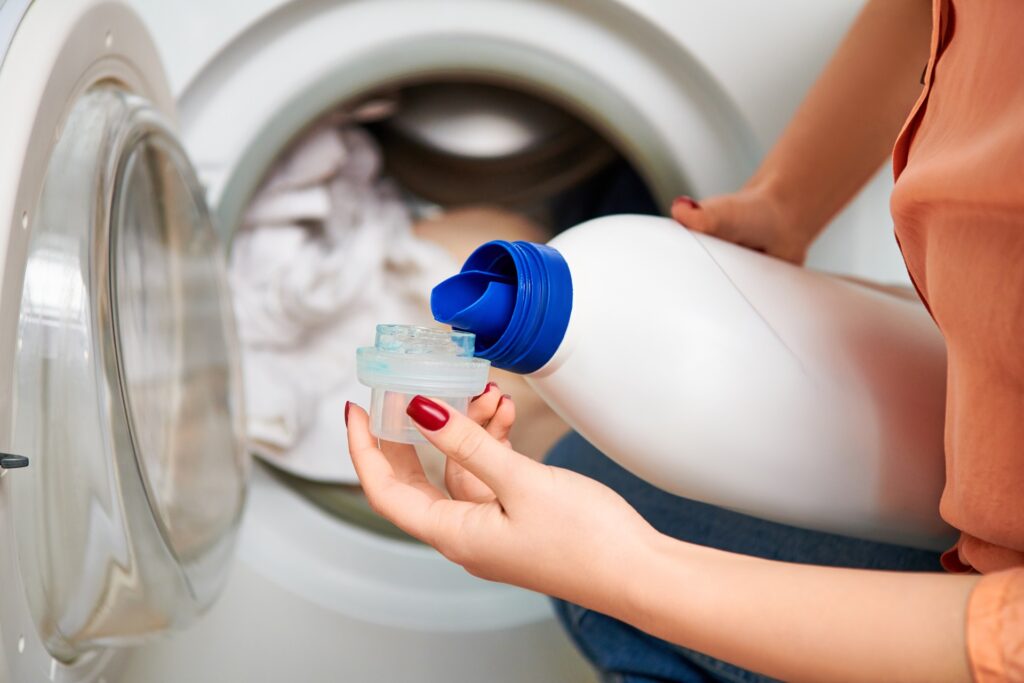Although it’s disappointing in some ways, with the proper care techniques, you can still keep your whites looking crisp and clean, no matter how packed your schedule gets. We cover those techniques in this article, so keep reading!
Separate Whites in the Wash
If you want to keep your white office uniforms looking crisp and bright, the first rule of thumb is to always separate your whites in the wash. Tossing them in with colored clothes might be convenient, but it’s a surefire way to dull that brilliant white over time.
Why Separating Whites Matters
- To Prevent Color Transfer: Even light colored garments can bleed dyes during the wash cycle. Mixing whites with colors can result in your uniforms picking up unwanted tints, leaving them looking dingy or gray.
- For Optimal Cleaning Conditions: Whites often require hotter water temperatures and specific detergents to maintain their brightness. Separating them allows you to customize the wash settings for the best results.
- For Effective Stain Removal: Whites show stains more prominently. Washing them separately lets you pretreat and focus on removing those pesky stains without affecting other clothes.
Pretreat Stains Immediately
When it comes to keeping your white office uniforms spotless, timing is everything. The moment you notice a stain, it’s crucial to pretreat it right away. Waiting even a few hours allows the stain to set, making it much harder or even impossible to remove later on. By acting fast and using the proper techniques, you can prevent those pesky stains from becoming permanent marks on your crisp whites.
How to Pretreat Different Stain Types
Tannin Stains (Coffee, Tea, Wine)
To handle tannin stains, avoid using soap directly, as it can actually set the stain. Rinse the stain with cold water first, then treat it with a stain remover formulated for tannin stains or a mix of water and white vinegar.
Additional Tip: Avoid heat when treating tannin stains, as high temperatures can make them more difficult to remove.
Oil-based Stains (Grease, Salad Dressing, Butter)
These stains are best tackled quickly, as they can seep deep into fabrics, especially natural materials. Sprinkle a small amount of cornstarch or baking soda on the stain and let it sit for a few minutes to absorb the oil. Brush it off, then apply a liquid dish detergent directly to the stain.
Additional Tip: Gently scrub the area with a soft brush or cloth before washing, as this helps break down the oils.
Protein-based Stains (Blood, Sweat, Dairy)
Using hot water right away can actually set these stains, so a little patience goes a long way. Start with cold water, soaking the stained area to dissolve as much of the protein as possible. Then, use an enzyme-based stain remover or a small amount of diluted ammonia.
Additional Tip: Always test ammonia on a hidden area of the fabric first, as it may not be safe for all materials.
Use the Right Detergent
Each type of detergent has unique benefits for fabric care, stain removal, and eco-friendliness, so let’s dive into how to choose the correct product for brilliant, clean whites.
Optical Brighteners for Vibrancy
Detergents designed specifically for whites often contain optical brighteners, which help enhance the whiteness of fabrics. These additives reflect light to make the fabric appear brighter, helping keep your white clothes looking vibrant wash after wash.
Additional Tip: To avoid dulling, stick with detergents formulated for white clothing that are free from unnecessary dyes and perfumes. These additives can leave residues, making your whites appear less bright over time.
Consider Liquid vs. Powder Detergent
Each detergent type—liquid or powder—has strengths depending on your laundry needs.
- Liquid Detergents are ideal for pretreating stains before a wash, as they can be applied directly to the stain for effective removal. This makes them a great choice if you need a versatile option for everyday use.
- Powder Detergents work best on heavily soiled clothes, making them suitable if your whites often get exposed to outdoor dirt or heavier stains. Powders are especially effective for deep cleaning in hard water.
Add a Whitening Agent
Whitening agents are designed to lift stains, counteract yellowing, and enhance the brightness of white fabrics. Incorporating the proper whitening solution will not only make your whites look better but will also help them last longer by reducing the need for harsh treatments down the line.
Whitening agents include:
- Oxygen bleach
- Bluing agents
- Lemon juice and baking soda
How to Effectively Use Whitening Agents
- Follow Dosage Instructions: Always check the product label for recommended amounts. Overusing a whitening agent can sometimes cause residue or uneven results.
- Add to the Wash Cycle: Most whitening agents can be added directly to the wash cycle along with your detergent. For tougher stains, consider soaking your uniforms in a mixture of water and whitening agent before washing.
- Avoid Mixing with Chlorine Bleach: Some whitening agents, especially oxygen-based, should not be combined with chlorine bleach, as the chemical reaction can damage the fabric.
For Best Results
- Soak for Stubborn Stains: For uniforms with heavy staining, soaking them in a mixture of water and whitening agents for 30 minutes to an hour can enhance stain removal.
- Wash in Hot Water When Safe: Hot water activates many whitening agents, improving their effectiveness. However, always check your uniform’s care label to ensure it can withstand higher temperatures.
- Rinse Thoroughly: After using a whitening agent, make sure to run an extra rinse cycle if needed to prevent any leftover residue that could dull the fabric over time.
Use a Fabric Softener Sparingly

Fabric softeners add a lovely softness and fresh scent to your laundry, but when it comes to white office uniforms, less is definitely more. While fabric softeners can make clothing items feel softer, using too much can lead to unwanted buildup, dulling the fabric and even affecting its absorbency over time.
Alternatives to Fabric Softener
- Try White Vinegar: Add a half-cup of white vinegar to the rinse cycle as a natural alternative to fabric softener. It softens clothes without leaving any residue and even helps maintain the brightness of whites.
- Use Dryer Balls: Wool or silicone dryer balls soften fabrics naturally by breaking up stiffness in the dryer, making them a great reusable alternative.
- Look for Fabric-safe Softeners: Some fabric softeners are specially formulated for sensitive fabrics and white wardrobes, providing a lighter, less intense softening effect.
Tips for Safely Using Fabric Softener
- Dilute Before Adding: If you choose to use fabric softener, dilute it with water before adding it to the rinse cycle to avoid concentrated buildup on fabrics.
- Use in Every Other Wash: Instead of using fabric softener with every wash, try applying it every other time to limit residue without sacrificing softness.
- Follow Dosage Recommendations: Always follow the recommended amount on the label. Using more won’t make clothes softer but will increase residue and dullness.
Refresh Midweek with a Fabric Refresher
By the middle of the week, even your freshest white clothing uniforms might start to feel less than pristine. Instead of running them through another wash cycle, give them a quick pick-me-up with a fabric refresher. It’s an easy, time saving trick that helps maintain your professional appearance throughout the week.
How to Effectively Use a Fabric Refresher
- Hang Your Uniform: Place your uniform on a hanger in a well-ventilated area to allow for even application and quick drying.
- Spray Evenly: Hold the fabric refresher about 6-8 inches away and lightly mist the garment, focusing on areas like underarms, collars, and cuffs.
- Allow to Air Dry: Let the uniform air out for a few minutes before wearing to ensure it’s completely dry and the scent has settled.
Choosing the Correct Fabric Refresher
- Opt for Gentle Formulas: Select a refresher that’s safe for all fabrics to avoid any potential damage to delicate textiles.
- Fragrance-free Options: If you’re sensitive to scents or work in a scent-free environment, choose a fragrance-free product that still effectively neutralizes odors.
- Eco-friendly Choices: Look for environmentally friendly options made with natural ingredients and free of harsh chemicals.
Additional Tips
- First try the fabric refresher on a small, hidden area to ensure it doesn’t affect the color or texture of your uniform.
- Use in conjunction with other tips like proper storage and minimal use of fabric softeners to keep your uniforms in top shape.
- Don’t forget to freshen up ties, scarves, or other accessories that are part of your uniform ensemble.
Achieve Brilliant, Stain-free White Uniforms – Trust Faulkner’s Fine Dry Cleaning for Expert Care!
Keeping your white office uniforms looking bright and fresh all week is possible with the proper tips and a bit of knowhow. But if you need an extra hand to maintain that crisp, stain-free look, let Faulkner’s Fine Dry Cleaning handle it for you. Established in 1954, Faulkner’s Fine Dry Cleaning has been the trusted name in the Dallas area for generations, known for its exceptional care of all fabrics, from uniforms to delicate linens and even comforters.
As a family-owned business, we’re committed to both quality and environmental responsibility. Our services include same-day dry cleaning and laundry, along with free pickup and delivery at our Oak Lawn and Lakewood locations. Book your pickup today and let us handle the rest!

